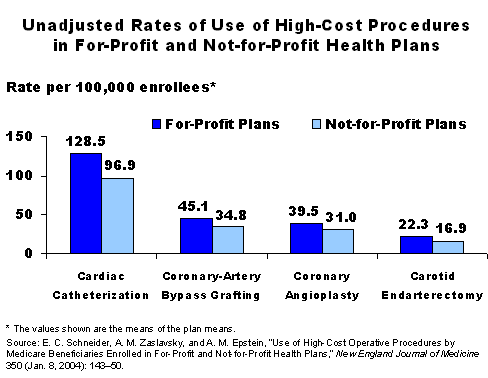With about 4.5 million Medicare beneficiaries enrolled in managed care plans, and many policymakers advocating actions to increase this number, some have expressed concern that, in seeking to control costs, for-profit plans will limit provision of needed health care to enrollees. But are for-profit health plans more likely than not-for-profit plans to respond to financial pressures by seeking to limit access to care? A new study supported by The Commonwealth Fund found that this has not been the case for Medicare beneficiaries. The study found that rates of use of high-cost procedures were not lower among beneficiaries enrolled in for-profit health plans than among those enrolled in not-for-profit plans.
In Use of High-Cost Operative Procedures by Medicare Beneficiaries Enrolled in For-Profit and Not-for-Profit Health Plans, Eric C. Schneider and Arnold M. Epstein of the Harvard School of Public Health and Alan M. Zaslavsky of Harvard Medical School tested the hypothesis that rates of use for 12 high-cost procedures would be lower in for-profit health plans than in not-for-profit plans. The authors analyzed HEDIS data from 1997 for 3.7 million Medicare beneficiaries age 65 and older enrolled in 166 for-profit plans and 88 not-for-profit plans.
Findings
The study found that four procedures—carotid endarterectomy, cardiac catheterization, coronary-artery bypass grafting, and coronary angioplasty—were actually used more often in for-profit plans than not-for-profit plans, while the rates of use of the other procedures were comparable between the two types of plans (see figure). The rates of use were not lower for enrollees in for-profit plans than for those in not-for-profit plans for any of the 12 procedures.
Plan Characteristics
The authors then took into account plans' geographic location and enrollee and plan characteristics. Among the study sample, 69 percent of beneficiaries were enrolled in for-profit plans and 31 percent were in not-for-profit plans. For-profit plans enrolled a higher mean percentage of black beneficiaries (11% vs. 6% for not-for-profit plans) and a higher percentage of beneficiaries with a low level of education (25% vs. 16%). Not-for-profit plans enrolled a higher percentage of rural residents (9% vs. 6%).
The researchers used the differences in plan characteristics to adjust the data to account for any variability that may be explained by factors other than plan ownership.
When they adjusted the results for sociodemographic case mix of the health plans, the differences in rates of procedures were similar to the unadjusted differences. Adjusting for other health plan characteristics did not substantially alter the results. For-profit plans still had at least somewhat higher rates of using all of the 12 high-cost procedures. However, after adjusting for case mix and other characteristics, the higher use rate was statistically significant for only two of the 12 procedures. Geographic location of the health plans did not explain the results.
Conclusions
The authors note that their results are "somewhat counterintuitive." It would seem that for-profit health plans would have a financial incentive to lower costs and increase shareholder value by restricting costly medical procedures. One possible explanation posited by the researchers is a difference in leadership between the two types of plans.
"Leaders of not-for-profit plans may be more adept than leaders of for-profit plans at implementing the clinical programs that can reduce the need for procedures," they say. "Leaders of for-profit plans may focus primarily on obtaining price discounts or trimming ancillary services, rather than on reducing the number of procedures itself."
The authors also note that because the rates of use were very similar between for-profit and not-for-profit plans, both types may be using similar approaches to control costs. In addition, the data did not allow the authors to address whether higher or lower rates of procedure use would be optimal.
Facts and Figures
- For-profit health plans are not more likely than not-for-profit plans to restrict use of high-cost medical procedures for Medicare beneficiaries.
- Rates of use of 12 costly medical procedures were similar between for-profit and not-for-profit plans, with for-profit plans having higher rates of use for four procedures.
- Adjusting the data for sociodemographic factors and geographic locations of plan markets did not substantially change the results.
